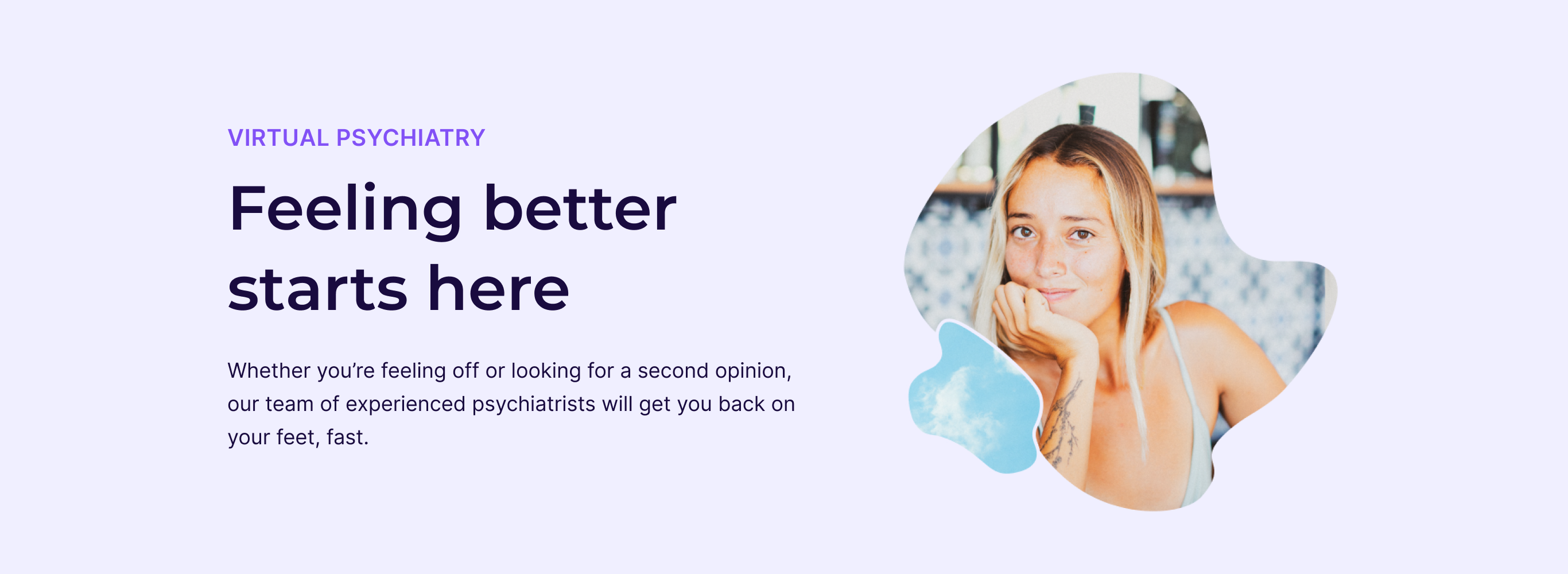
Background
Virgil team currently Prescribes and Treats patients with a combination of Medication + Therapy programs, but does not offer comprehensive care that we cannot fully diagnose patients with mental health concerns that find our service.
We aimed to pilot an offering of Psychiatrist visits, with a Psychiatrist who holds an MD and can be an addition to the care team to provide diagnosis and high level exception management.
Problem alignment
Since a custom task schedule was a new feature to be implemented to the already predefined schedule option, I used a Hierarchial Task Analysis that could help me to generate ideas of the steps that a user must take in order to complete a goal.
My process of a Hierarchial Task Analysis was broken down into the following steps:
Since a custom task schedule was a new feature to be implemented to the already predefined schedule option, I used a Hierarchial Task Analysis that could help me to generate ideas of the steps that a user must take in order to complete a goal.
My process of a Hierarchial Task Analysis was broken down into the following steps:
- Patients who do not currently have a diagnosis are not offered the full suite of services from Virgil
- Patients trust MDs and these are not currently part of our care team offering
Objective
Since a custom task schedule was a new feature to be implemented to the already predefined schedule option, I used a Hierarchial Task Analysis that could help me to generate ideas of the steps that a user must take in order to complete a goal.
My process of a Hierarchial Task Analysis was broken down into the following steps:
Since a custom task schedule was a new feature to be implemented to the already predefined schedule option, I used a Hierarchial Task Analysis that could help me to generate ideas of the steps that a user must take in order to complete a goal.
My process of a Hierarchial Task Analysis was broken down into the following steps:
- Validate Psychiatry as a mechanism to grow Virgil’s key treatment programs
- Psychiatry increases patient volume for key programs: Medications + Therapy
- Psychiatry increases patient volume for key new program: IOP (Intensive Outpatient Program)
- Launch a pilot testing (phase 1): Capture Demand Intent from marketing by using no-code solutions.
What does success look like?
Since a custom task schedule was a new feature to be implemented to the already predefined schedule option, I used a Hierarchial Task Analysis that could help me to generate ideas of the steps that a user must take in order to complete a goal.
My process of a Hierarchial Task Analysis was broken down into the following steps:
Since a custom task schedule was a new feature to be implemented to the already predefined schedule option, I used a Hierarchial Task Analysis that could help me to generate ideas of the steps that a user must take in order to complete a goal.
My process of a Hierarchial Task Analysis was broken down into the following steps:
- Interest in Psychiatry offering:
a. Total demand for offering
b. Cost-per-lead for psychiatry offering - Viability of business line:
a. Paid converted Psychiatry users
b. Insurance vs Cash-Pay Patients
Team for launching a pilot test
- Director of Product
- Head of Growth
- Growth manager
- Senior Director Of Engineering
- Software engineer
- Clinical Director
- Senior Manager
- Product designer — me ?
- Brand Lead
- Visual designer
- Ops, Admissions, and Clinical teams
Team for user research
- Design Director
- Product designer + me ?
My role
- Lead design, eng, brand, growth, and ops teams to ship a MVP version of a new product offering
- Conduct user research and get deeper into understanding patients’ motivations and pains
Understanding the user journey
In order to understand the main patient touch points + business operations, I created a flowchart that helped me to define main steps patients will go through, and how the business will operate under this pilot.
- Facebook ads
- Landing page
- Booking flow
- Calendly
- Stripe
- Ops side: integrations with Salesforce + Zapier + Slack
Once the user flow diagram was finalized and approved with the rest of the team, we were able to move on next.

A flowchart with main user touch points
Aligning with brand and growth teams
The goal during this step was to align with the teams and make sure everyone understands required output and the launch date. I followed up with a brand and a growth teams on the following:
- Facebook ads
- Landing page
- Visual design
- Content
- Design an approved version of a LP on Unbounce
- Work on required marketing integrations

Assets for a marketing campaign
A Jotform web booking flow
I worked on a web booking flow, and needed to align on the following:
- Create wireframes and align on business logic
- Get help from the branding team with copy
- Work on CSS to apply UI based on our branding
- Conduct QA with the team, so we could cover up broad use cases
- Align with the eng team on their side for integrations (setting up a sub-domain and Zapier integrations for Slack notifications)
The wireframes I prepared were based on our main Virgil’s web booking flow. I just needed to update the user flow, disqualifiers and content for the psychiatry pilot.
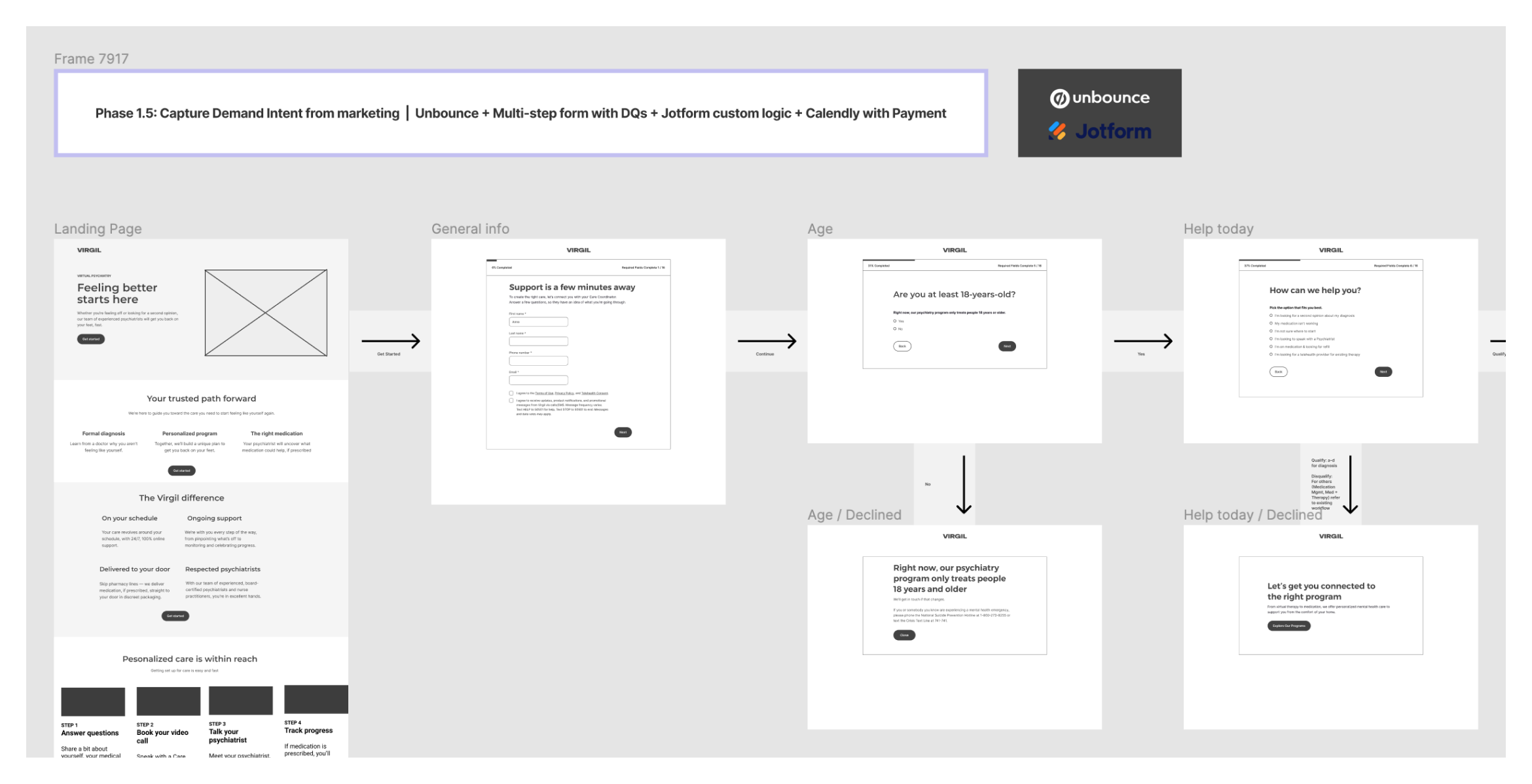
Wireframes for a Jotfrom web booking flow
Going live
Once everything was ready, I needed to be sure that all business verticals were aligned on the launch date, and everyone was ready to work with patients when needed.
- Product team — the user journey was aligned with the business requirements
- Growth team — ready to push live marketing campaigns
- Ops team — business operations are set as needed to run this pilot
- Admission + clinical teams — able to take care of incoming patients
Measuring results
These results were measured in 14 days after a pilot test launch. We saw a traction that Psychiatry Offering can be a potential treatment program which could be added to our already existing services.
4 booked appointments
- 3 from Virgil admissions phone line
- 1 from Diagnosis web-booking flow
42 qualified sign ups
- Seeking psych medical doctor: 28
- Not sure where to start: 11
- Meds not working: 3
19 never been diagnosed or unsure
- Previous diagnosis: 23
- Last known diagnosis more than 1 year ago: 18
- Last known diagnosis more than 1 year ago: 5
A deep dive into user research
Based on the pilot test, we received some traction, but we didn’t understand why that was happening and what patients' motivations were. In order to better understand our patients, their goals and needs the design team worked on a research plan.
Research goal
- Understand the patients' pains and needs when looking for a psychiatry solution
- Understand constraints and limitations that any solution should take into consideration (i.e. platform, legal, provider constraints…)
- Identify opportunities to improve and optimize current experience
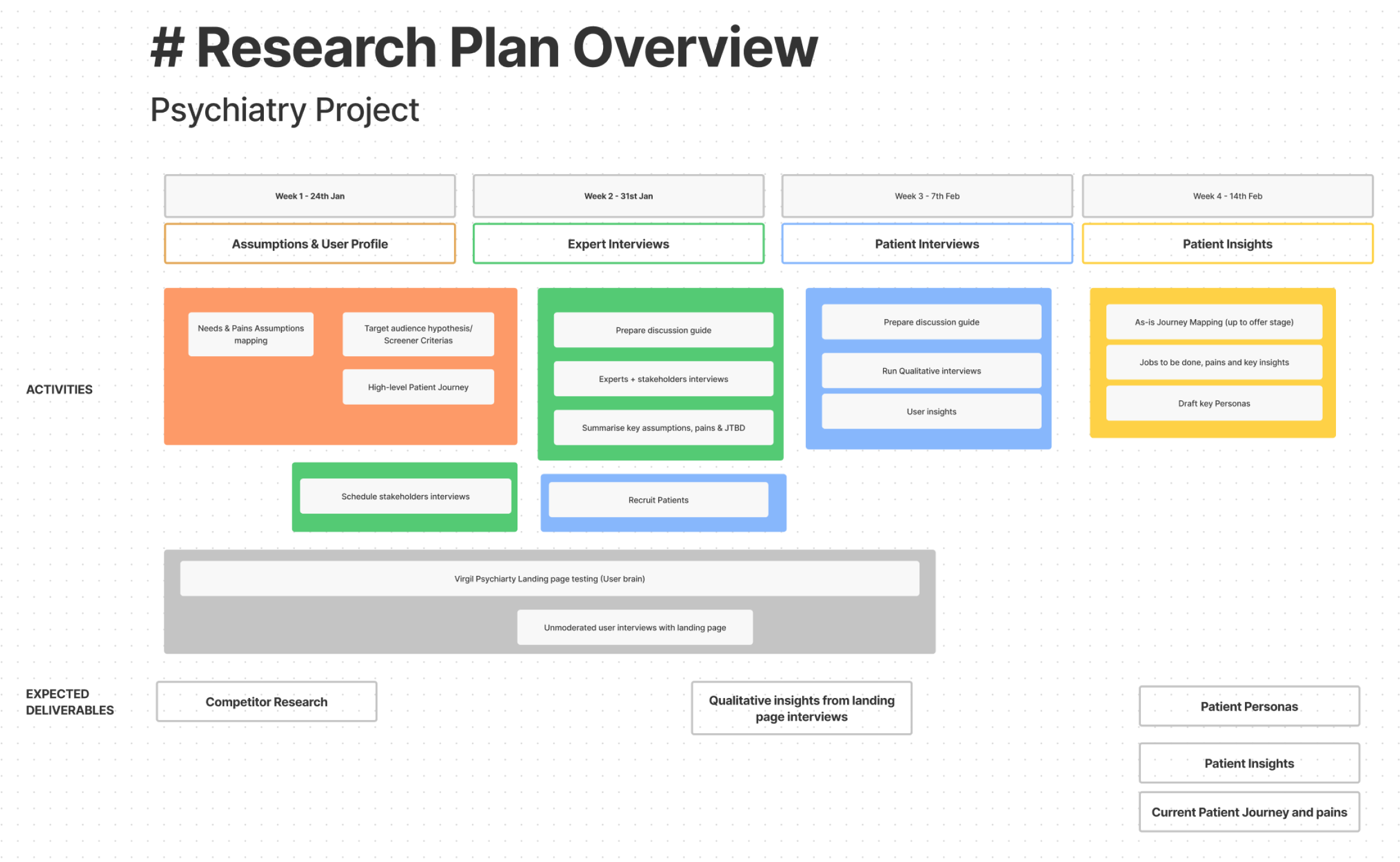
A research plan
High-level plan
Assumptions & user profiling — map key assumptions and priorities to test and define screener criteria for who we want to interview.
- Re-assess and identify any gaps in the current research plan i.e. is there any quant research we can do to validate any of the open assumptions
Competitor research — understand current solutions and competitors' value proposition.
- Understand current solutions and competitors´value proposition
Quant testing — ads or landing page experiments.
- Identify which assumptions can be easily tested through ads or landing page experiment
- Create assets needed for testing i.e. landing page, survey questions, concept mockups
- Define the experiment, including the hypothesis that are going to be tested, and what metrics we are going to use to measure the performance of experiment
Expert interviews — interview “experts” in the psychiatry process to gather their perspective on where the key pains and inefficiencies exist.
- Schedule 30 min chats with key stakeholders
- Define an interview guide
- Run interviews & and note taking
User interviews — recruit participants that meet the screener criteria.
- Recruit participants that meet the screener criteria
- Define an interview guide
- Run qualitative interviews & and note taking
User insights & personas
- As-is journey mapping to understand the current experience, pains, and needs and set the foundation to ideate on potential solutions
- Summary of key pains, jobs to be done and user insights
- Key personas and target profiling
Getting ready for user interviews
Another designer and I worked on a patient discussion guide to kick off our user interviews.
Objectives
- Understand patient's jobs-to-be-done, what they were hoping to achieve/find when they visited Virgil
- What are the main reasons why they decided to join or not to join
- Identify potential opportunity areas for the Psychiatry offering
- Identify different personas & needs
Methodology
- 30 mins interviews
- Open-ended questions
Patients we planed to interview
- Number of interviews we plan to run: 6 unmoderated interviews
- Age: 18 - 50 years old
- Country: United States of America
The designer and I also worked on the following details:
- Prepared patient discussion guides for user interviews
- Conducted 3 user interviews
- Using Dovetailapp transcribed recorded user interviews, analyze data, and define patterns for possible insights
- Extracted learnings into a deck, and present it them for the team
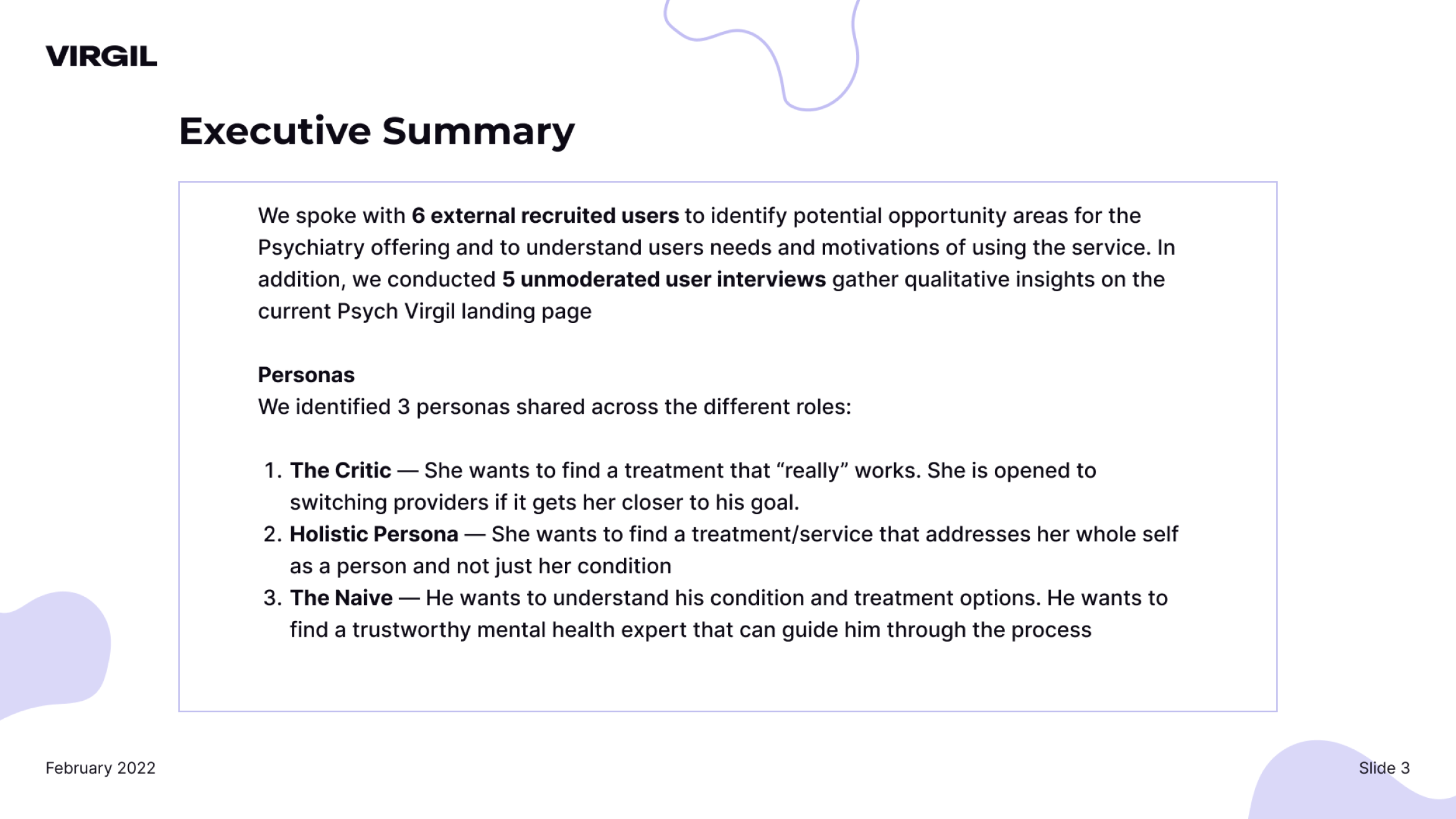
Executive summary with identified personas
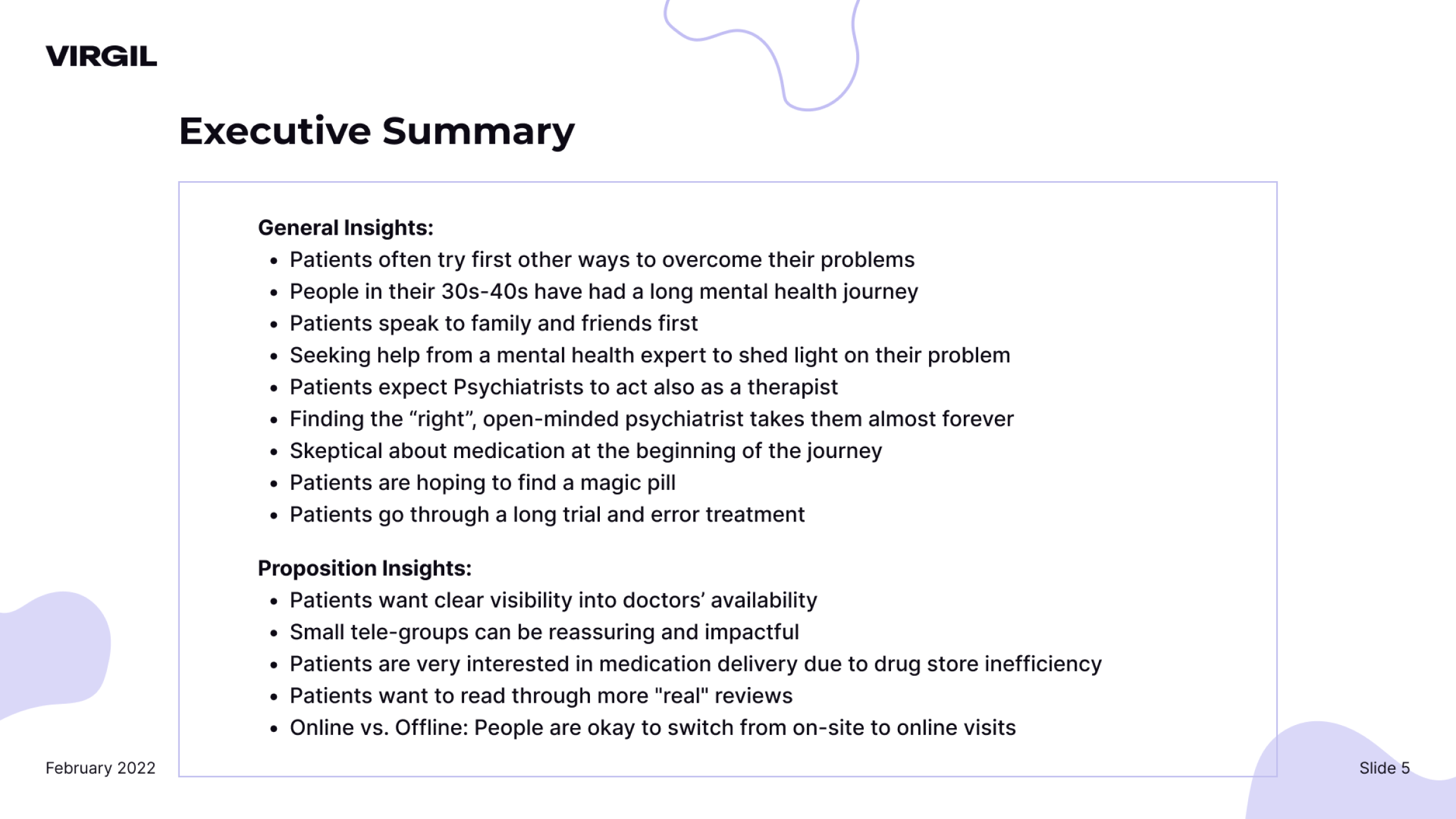
Executive summary with insights
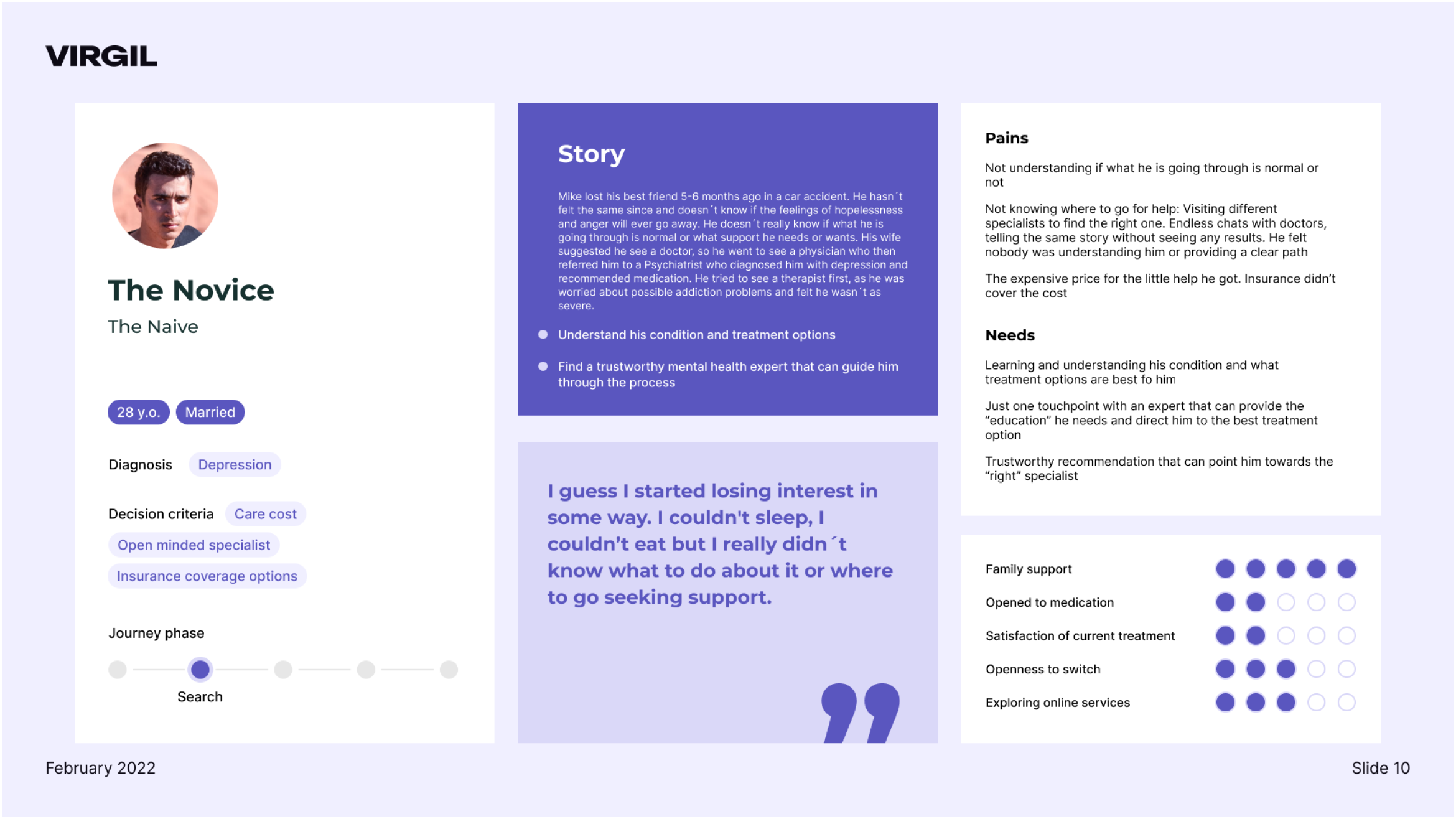
First persona
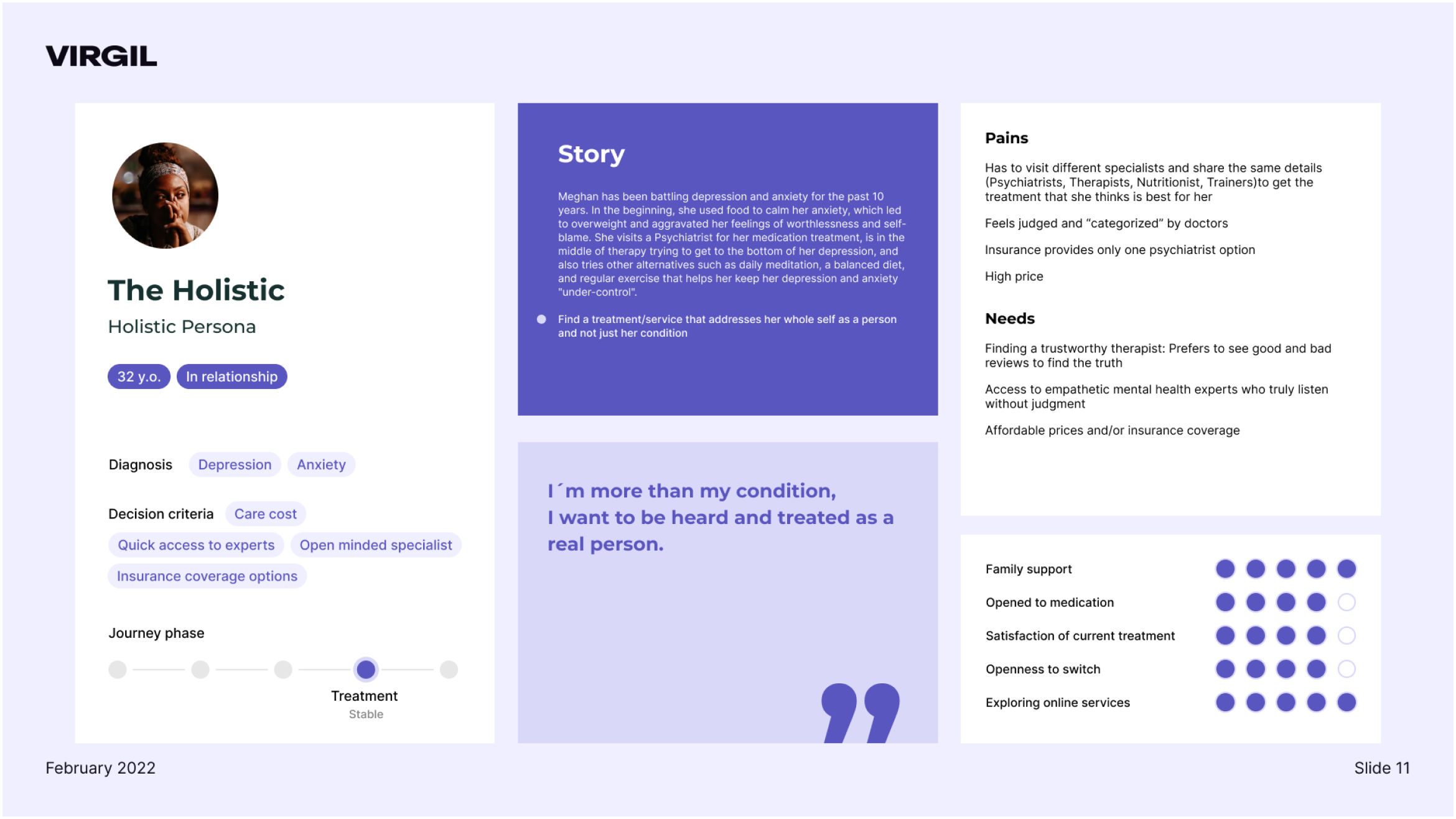
Second persona
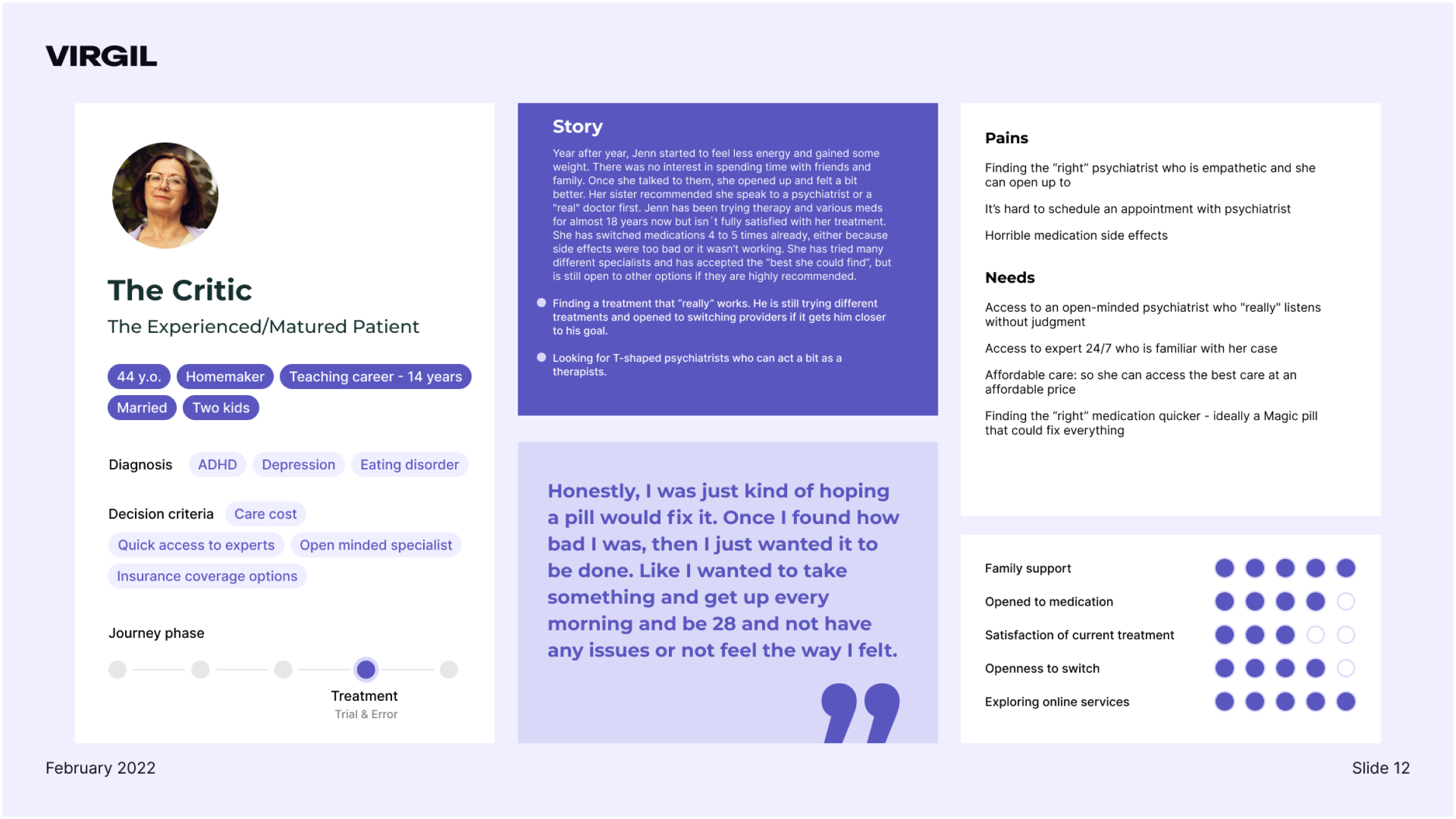
Third persona
?? What I have learned
Aligning with multiple teams on the same pilot test could be challenging. Especially if there is a tough deadline. But it must be fun and engaging, because this should create great environment for collaboration and innovation for solving complex problems. And that’s where research comes handy. Understanding user motivations, goals, and insights creates a solid foundation to move to the right direction.